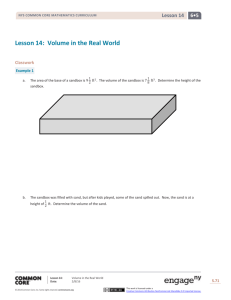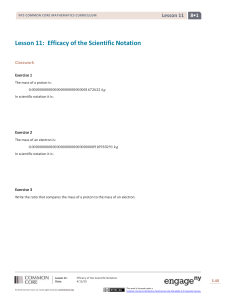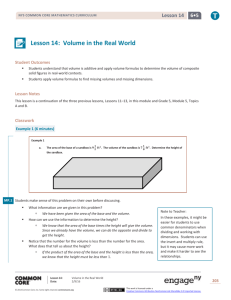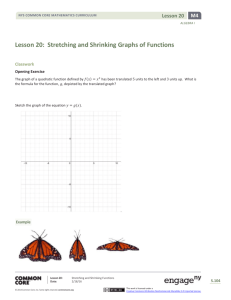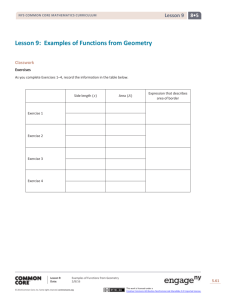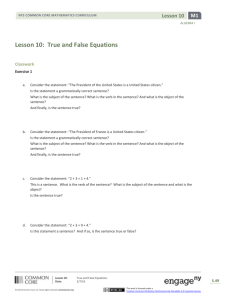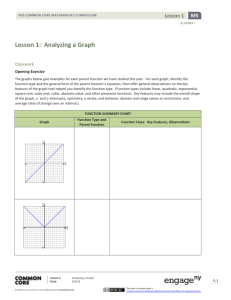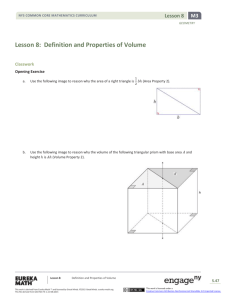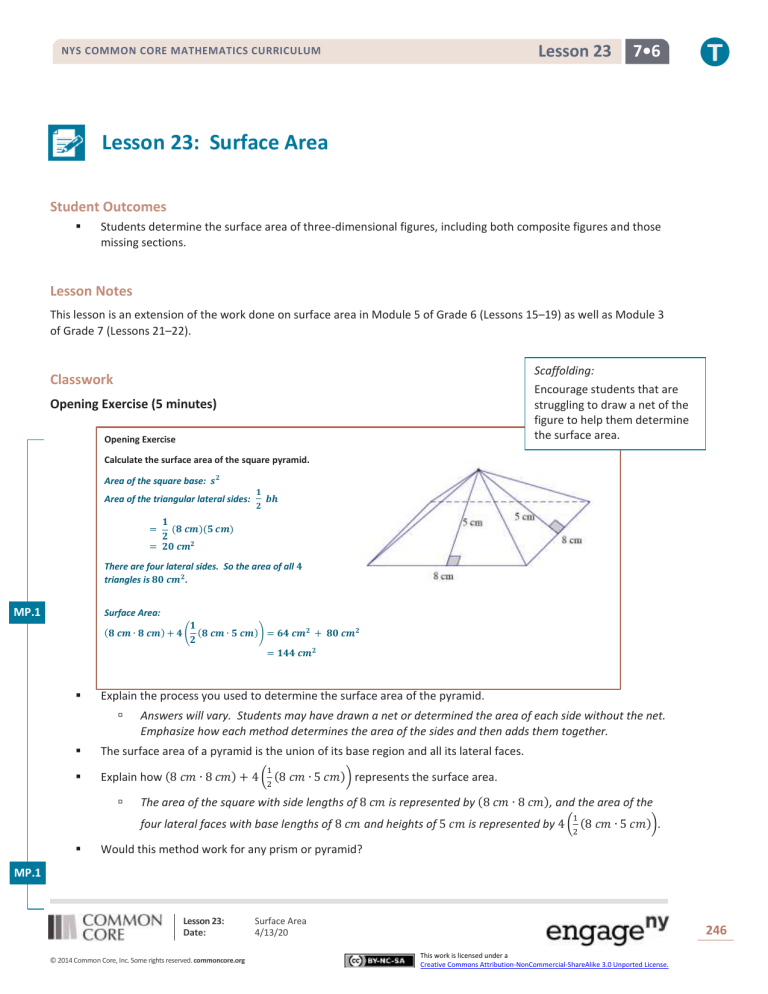
Lesson 23
NYS COMMON CORE MATHEMATICS CURRICULUM
7•6
Lesson 23: Surface Area
Student Outcomes
Students determine the surface area of three-dimensional figures, including both composite figures and those
missing sections.
Lesson Notes
This lesson is an extension of the work done on surface area in Module 5 of Grade 6 (Lessons 15–19) as well as Module 3
of Grade 7 (Lessons 21–22).
Scaffolding:
Classwork
Encourage students that are
struggling to draw a net of the
figure to help them determine
the surface area.
Opening Exercise (5 minutes)
Opening Exercise
Calculate the surface area of the square pyramid.
Area of the square base: 𝒔𝟐
Area of the triangular lateral sides:
𝟏
𝟐
𝒃𝒉
𝟏
(𝟖 𝒄𝒎)(𝟓 𝒄𝒎)
𝟐
= 𝟐𝟎 𝒄𝒎𝟐
=
There are four lateral sides. So the area of all 𝟒
triangles is 𝟖𝟎 𝒄𝒎𝟐.
MP.1
Surface Area:
𝟏
(𝟖 𝒄𝒎 ∙ 𝟖 𝒄𝒎) + 𝟒 ( (𝟖 𝒄𝒎 ∙ 𝟓 𝒄𝒎)) = 𝟔𝟒 𝒄𝒎𝟐 + 𝟖𝟎 𝒄𝒎𝟐
𝟐
= 𝟏𝟒𝟒 𝒄𝒎𝟐
Explain the process you used to determine the surface area of the pyramid.
Answers will vary. Students may have drawn a net or determined the area of each side without the net.
Emphasize how each method determines the area of the sides and then adds them together.
The surface area of a pyramid is the union of its base region and all its lateral faces.
Explain how (8 𝑐𝑚 ∙ 8 𝑐𝑚) + 4 ( (8 𝑐𝑚 ∙ 5 𝑐𝑚)) represents the surface area.
1
2
The area of the square with side lengths of 8 𝑐𝑚 is represented by (8 𝑐𝑚 ∙ 8 𝑐𝑚), and the area of the
1
four lateral faces with base lengths of 8 𝑐𝑚 and heights of 5 𝑐𝑚 is represented by 4 ( (8 𝑐𝑚 ∙ 5 𝑐𝑚)).
2
Would this method work for any prism or pyramid?
MP.1
Lesson 23:
Date:
© 2014 Common Core, Inc. Some rights reserved. commoncore.org
Surface Area
4/13/20
246
This work is licensed under a
Creative Commons Attribution-NonCommercial-ShareAlike 3.0 Unported License.
Lesson 23
NYS COMMON CORE MATHEMATICS CURRICULUM
7•6
Answers will vary. Students should come to the conclusion that calculating the area of each lateral face
will determine the surface area even if the areas are determined in different orders, by using a formula
or net, or any other method.
Example 1 (10 minutes)
Students find the surface area of the rectangular prism. Then students will determine the
surface area of the rectangular prism when it is broken into two separate pieces. Finally,
students will compare the surface areas before and after the split.
Scaffolding:
Students may benefit from a
physical demonstration of this,
perhaps using base ten blocks.
Example 1
a.
Calculate the surface area of the rectangular prism.
Surface Area:
𝟐(𝟑 𝒊𝒏.× 𝟔 𝒊𝒏. ) + 𝟐(𝟑 𝒊𝒏.× 𝟏𝟐 𝒊𝒏. ) + 𝟐(𝟔 𝒊𝒏.× 𝟏𝟐 𝒊𝒏. )
= 𝟐(𝟏𝟖 𝒊𝒏𝟐 ) + 𝟐(𝟑𝟔 𝒊𝒏𝟐 ) + 𝟐(𝟕𝟐 𝒊𝒏𝟐 )
= 𝟑𝟔 𝒊𝒏𝟐 + 𝟕𝟐 𝒊𝒏𝟐 + 𝟏𝟒𝟒 𝒊𝒏𝟐
= 𝟐𝟓𝟐 𝒊𝒏𝟐
MP.3
Have students predict in writing or in discussion with a partner whether or not the sum of the two surface areas in part
(b) will be the same as the surface area in part (a).
b.
Imagine that a piece of the rectangular prism is removed. Determine the surface area of both pieces.
The surface area of the shape on the left:
Area for front and back sides:
𝟐 (𝟑 𝒊𝒏. × 𝟔 𝒊𝒏. )
= 𝟐(𝟏𝟖 𝒊𝒏𝟐 ) = 𝟑𝟔 𝒊𝒏𝟐
Area for front and back sides:
𝟐(𝟑 𝒊𝒏.× 𝟑 𝒊𝒏. )
= 𝟐(𝟗 𝒊𝒏𝟐 ) = 𝟏𝟖 𝒊𝒏𝟐
Area seen from left and right:
𝟐(𝟑 𝒊𝒏.× 𝟏𝟐 𝒊𝒏. )
= 𝟐(𝟑𝟔 𝒊𝒏𝟐 ) = 𝟕𝟐 𝒊𝒏𝟐
Area for left and right sides:
𝟐(𝟑 𝒊𝒏.× 𝟔 𝒊𝒏. )
= 𝟐(𝟏𝟖 𝒊𝒏𝟐 ) = 𝟑𝟔 𝒊𝒏𝟐
Area for top and bottom:
𝟐(𝟑 𝒊𝒏.× 𝟔 𝒊𝒏. )
= 𝟐(𝟏𝟖 𝒊𝒏𝟐 ) = 𝟑𝟔 𝒊𝒏𝟐
Area of extra sides:
Area of top and bottom:
Surface area:
The surface area of the shape on the right:
𝟐(𝟑 𝒊𝒏.× 𝟑 𝒊𝒏. )
= 𝟐(𝟗 𝒊𝒏𝟐 ) = 𝟏𝟖 𝒊𝒏𝟐
𝟐(𝟔 𝒊𝒏.× 𝟏𝟐) − 𝟐(𝟔 𝒊𝒏.× 𝟑 𝒊𝒏. )
= 𝟐(𝟕𝟐 𝒊𝒏𝟐 ) − 𝟐(𝟏𝟖 𝒊𝒏𝟐 )
= 𝟏𝟒𝟒 𝒊𝒏𝟐 − 𝟑𝟔 𝒊𝒏𝟐 = 𝟏𝟎𝟖 𝒊𝒏𝟐
Surface area:
𝟖 𝒊𝒏𝟐 + 𝟑𝟔 𝒊𝒏𝟐 + 𝟑𝟔 𝒊𝒏𝟐
= 𝟗𝟎 𝒊𝒏𝟐
𝟑𝟔 𝒊𝒏𝟐 + 𝟕𝟐 𝒊𝒏𝟐 + 𝟏𝟖 𝒊𝒏𝟐 + 𝟏𝟎𝟖 𝒊𝒏𝟐
= 𝟐𝟑𝟒 𝒊𝒏.𝟐
How did you determine the surface area of the shape on the left?
Lesson 23:
Date:
© 2014 Common Core, Inc. Some rights reserved. commoncore.org
Surface Area
4/13/20
247
This work is licensed under a
Creative Commons Attribution-NonCommercial-ShareAlike 3.0 Unported License.
Lesson 23
NYS COMMON CORE MATHEMATICS CURRICULUM
7•6
I was able to calculate the area of the sides that are rectangles using length times width. For the two
bases that are C-shaped, I used the area of the original top and bottom and subtracted the piece that
was taken off.
c.
How is the surface area in part (a) related to the surface area in part (b)?
If I add the surface area of both figures, I will get more than the surface area of the original shape.
𝟐𝟑𝟒 𝒊𝒏𝟐 + 𝟗𝟎 𝒊𝒏𝟐 = 𝟑𝟐𝟒 𝒊𝒏𝟐
𝟑𝟐𝟒 𝒊𝒏𝟐 − 𝟐𝟓𝟐 𝒊𝒏𝟐 = 𝟕𝟐 𝒊𝒏𝟐
𝟕𝟐 𝒊𝒏𝟐 is twice the area of the region where the two pieces fit together.
There are 𝟕𝟐 more square inches when the prisms are separated.
Exercises 1–5 (18 minutes)
Exercises 1–5
Determine the surface area of the right prisms.
1.
Area of top and bottom:
𝟏
𝟐
𝟐 ( (𝟏𝟓 𝒇𝒕.× 𝟖 𝒇𝒕. )) =
𝟏𝟓 𝒇𝒕.× 𝟖 𝒇𝒕. = 𝟏𝟐𝟎 𝒇𝒕𝟐
Area for front:
𝟏𝟓 𝒇𝒕.× 𝟐𝟎 𝒇𝒕. = 𝟑𝟎𝟎 𝒇𝒕𝟐
Area that can be seen from left:
𝟏𝟕 𝒇𝒕.× 𝟐𝟎 𝒇𝒕. = 𝟑𝟒𝟎 𝒇𝒕𝟐
Area that can be seen from right:
𝟖 𝒇𝒕.× 𝟐𝟎 𝒇𝒕. = 𝟏𝟔𝟎 𝒇𝒕𝟐
Surface area: 𝟏𝟐𝟎 𝒇𝒕𝟐 + 𝟑𝟎𝟎 𝒇𝒕𝟐 + 𝟑𝟒𝟎 𝒇𝒕𝟐 + 𝟏𝟔𝟎 𝒇𝒕𝟐 = 𝟗𝟐𝟎 𝒇𝒕𝟐
2.
Area of front and back:
𝟏
𝟐
𝟐 ( (𝟏𝟎 𝒚𝒅. + 𝟒 𝒚𝒅. )𝟒𝒚𝒅. ) =
𝟏𝟒 𝒚𝒅.× 𝟒 𝒚𝒅. = 𝟓𝟔 𝒚𝒅𝟐
Area of top:
Area that can be seen from left and right:
𝟒 𝒚𝒅.× 𝟏𝟓 𝒚𝒅. = 𝟔𝟎 𝒚𝒅𝟐
𝟐(𝟓 𝒚𝒅.× 𝟏𝟓 𝒚𝒅. ) =
𝟐(𝟕𝟓 𝒚𝒅.𝟐 ) = 𝟏𝟓𝟎 𝒚𝒅𝟐
Area of bottom:
𝟏𝟎 𝒚𝒅.× 𝟏𝟓 𝒚𝒅. = 𝟏𝟓𝟎 𝒚𝒅𝟐
Surface area: 𝟓𝟔 𝒚𝒅𝟐 + 𝟔𝟎 𝒚𝒅𝟐 + 𝟏𝟓𝟎 𝒚𝒅𝟐 + 𝟏𝟓𝟎 𝒚𝒅𝟐 = 𝟒𝟏𝟔 𝒚𝒅𝟐
3.
Area of top and bottom:
𝟐 ((𝟖 𝒇𝒕.× 𝟔 𝒇𝒕. ) + (𝟕 𝒇𝒕 × 𝟐 𝒇𝒕. ))
= 𝟐(𝟒𝟖 𝒇𝒕𝟐 + 𝟏𝟒 𝒇𝒕𝟐 )
= 𝟐(𝟔𝟐 𝒇𝒕𝟐 ) = 𝟏𝟐𝟒 𝒇𝒕𝟐
Lesson 23:
Date:
© 2014 Common Core, Inc. Some rights reserved. commoncore.org
Surface Area
4/13/20
Area for back:
𝟖 𝒇𝒕.× 𝟑 𝒇𝒕. = 𝟐𝟒 𝒇𝒕𝟐
Area for front:
𝟕 𝒇𝒕.× 𝟑 𝒇𝒕. = 𝟐𝟏 𝒇𝒕𝟐
Area of corner cut out:
248
𝟐
(𝟐 𝒇𝒕.×
𝟑 𝒇𝒕.
) + (𝟏under
𝒇𝒕.×a 𝟑 𝒇𝒕. ) = 𝟗 𝒇𝒕
This work
is licensed
Creative Commons Attribution-NonCommercial-ShareAlike 3.0 Unported License.
Area of right side:
𝟔 𝒇𝒕.× 𝟑 𝒇𝒕. = 𝟏𝟖 𝒇𝒕𝟐
Area of left side:
𝟖 𝒇𝒕.× 𝟑 𝒇𝒕. = 𝟐𝟒 𝒇𝒕𝟐
Lesson 23
NYS COMMON CORE MATHEMATICS CURRICULUM
7•6
Surface area: 𝟏𝟐𝟒 𝒇𝒕𝟐 + 𝟐𝟒 𝒇𝒕𝟐 + 𝟐𝟏 𝒇𝒕𝟐 + 𝟗 𝒇𝒕𝟐 + 𝟏𝟖 𝒇𝒕𝟐 + 𝟐𝟒 𝒇𝒕𝟐 = 𝟐𝟐𝟎 𝒇𝒕𝟐
4.
Surface area of top prism:
Area of top:
𝟒 𝒎 × 𝟓 𝒎 = 𝟐𝟎 𝒎𝟐
Area of front and back sides:
𝟐(𝟒 𝒎 × 𝟓 𝒎) = 𝟒𝟎𝒎𝟐
Area of left and right sides:
𝟐(𝟓 𝒎 × 𝟓 𝒎) = 𝟓𝟎 𝒎𝟐
Surface area of bottom prism:
Area of top:
𝟏𝟎 𝒎 × 𝟏𝟎 𝒎 − 𝟐𝟎 𝒎𝟐 = 𝟖𝟎 𝒎𝟐
Area of bottom:
𝟏𝟎 𝒎 × 𝟏𝟎 𝒎 = 𝟏𝟎𝟎 𝒎𝟐
Area of front and back sides:
𝟐(𝟏𝟎 𝒎 × 𝟑 𝒎) = 𝟔𝟎 𝒎𝟐
Area of left and right sides:
𝟐(𝟏𝟎 𝒎 × 𝟑 𝒎) = 𝟔𝟎 𝒎𝟐
Surface area: 𝟏𝟏𝟎 𝒎𝟐 + 𝟑𝟎𝟎 𝒎𝟐 = 𝟒𝟏𝟎 𝒎𝟐
5.
Area of top and bottom faces:
Area of lateral faces:
𝟐(𝟏𝟎 𝒊𝒏.× 𝟐 𝒊𝒏. ) + 𝟐(𝟔 𝒊𝒏.× 𝟐 𝒊𝒏. )
= 𝟒𝟎 𝒊𝒏𝟐 + 𝟐𝟒 𝒊𝒏𝟐
= 𝟔𝟒 𝒊𝒏𝟐
𝟐(𝟗 𝒊𝒏.× 𝟐 𝒊𝒏. ) + 𝟐(𝟔 𝒊𝒏.× 𝟗 𝒊𝒏. )
= 𝟑𝟔 𝒊𝒏𝟐 + 𝟏𝟎𝟖 𝒊𝒏𝟐 + 𝟐(𝟏𝟎 𝒊𝒏.× 𝟗 𝒊𝒏. )
= 𝟑𝟐𝟒 𝒊𝒏𝟐
Surface area:
𝟔𝟒 𝒊𝒏𝟐 + 𝟏𝟒𝟒 𝒊𝒏𝟐 + 𝟏𝟖𝟎 𝒊𝒏𝟐 = 𝟑𝟖𝟖 𝒊𝒏𝟐
Closing (2 minutes)
Describe the process you use to find the surface area of shapes that are composite figures or that are missing
sections.
To determine the surface area of a right prism, find the area of each lateral face and the two base
faces, then add the areas of all the faces together.
Exit Ticket (10 minutes)
Lesson 23:
Date:
© 2014 Common Core, Inc. Some rights reserved. commoncore.org
Surface Area
4/13/20
249
This work is licensed under a
Creative Commons Attribution-NonCommercial-ShareAlike 3.0 Unported License.
Lesson 23
NYS COMMON CORE MATHEMATICS CURRICULUM
Name
7•6
Date
Lesson 23: Surface Area
Exit Ticket
Determine and explain how to find the surface area of the following right prisms.
1.
2.
Lesson 23:
Date:
© 2014 Common Core, Inc. Some rights reserved. commoncore.org
Surface Area
4/13/20
250
This work is licensed under a
Creative Commons Attribution-NonCommercial-ShareAlike 3.0 Unported License.
Lesson 23
NYS COMMON CORE MATHEMATICS CURRICULUM
7•6
Exit Ticket Sample Solutions
Determine and explain how to find the surface area of the following right prisms.
1.
Area of top and bottom:
𝟏
𝟐 ( (𝟏𝟐 𝒇𝒕.× 𝟓 𝒇𝒕. ))
𝟐
= 𝟏𝟐 𝒇𝒕.× 𝟓 𝒇𝒕.
= 𝟔𝟎 𝒇𝒕𝟐
Area of front:
𝟏𝟐 𝒇𝒕.× 𝟏𝟓 𝒇𝒕.
= 𝟏𝟖𝟎 𝒇𝒕𝟐
Area seen from left:
𝟏𝟑 𝒇𝒕.× 𝟏𝟓 𝒇𝒕.
= 𝟏𝟗𝟓 𝒇𝒕𝟐
Area seen from right:
𝟓 𝒇𝒕.× 𝟏𝟓 𝒇𝒕.
= 𝟕𝟓 𝒇𝒕𝟐
Surface Area:
𝟔𝟎 𝒇𝒕𝟐 + 𝟏𝟖𝟎 𝒇𝒕𝟐 + 𝟏𝟗𝟓 𝒇𝒕𝟐 + 𝟕𝟓 𝒇𝒕𝟐
= 𝟓𝟏𝟎 𝒇𝒕𝟐
To find the surface area of the triangular prism, I must sum the areas of two triangles (the bases that are equal in
area) and the areas of three different sized rectangles.
2.
Area of front and back:
Area of sides:
Area of top and bottom:
𝟐(𝟏𝟎𝒇𝒕.× 𝟏 𝒇𝒕. ) = 𝟐𝟎 𝒇𝒕𝟐
𝟐(𝟏𝟎 𝒇𝒕.× 𝟏 𝒇𝒕. ) = 𝟐𝟎 𝒇𝒕𝟐
𝟐(𝟏𝟎 𝒇𝒕.× 𝟓 𝒇𝒕. ) + 𝟐( 𝟒 𝒇𝒕.× 𝟓 𝒇𝒕. )
= 𝟏𝟎𝟎 𝒇𝒕𝟐 + 𝟒𝟎 𝒇𝒕𝟐
= 𝟏𝟒𝟎 𝒇𝒕𝟐
Surface Area:
𝟐𝟎 𝒇𝒕𝟐 + 𝟐𝟎 𝒇𝒕𝟐 + 𝟏𝟒𝟎 𝒇𝒕𝟐
= 𝟏𝟖𝟎 𝒇𝒕𝟐
To find the surface area of the prism, I must sum the composite area of the bases with rectangular areas of the sides
of the prism.
Lesson 23:
Date:
© 2014 Common Core, Inc. Some rights reserved. commoncore.org
Surface Area
4/13/20
251
This work is licensed under a
Creative Commons Attribution-NonCommercial-ShareAlike 3.0 Unported License.
Lesson 23
NYS COMMON CORE MATHEMATICS CURRICULUM
7•6
Problem Set Sample Solutions
Determine the surface area of the figures.
1.
Area of top and bottom:
𝟐(𝟗 𝒄𝒎 × 𝟒 𝒄𝒎) = 𝟕𝟐 𝒄𝒎𝟐
Area of left and right sides:
𝟐(𝟒 𝒄𝒎 × 𝟗 𝒄𝒎) = 𝟕𝟐 𝒄𝒎𝟐
Area of front and back:
𝟐(𝟗 𝒄𝒎 × 𝟒 𝒄𝒎) + 𝟐(𝟒. 𝟓 𝒄𝒎 × 𝟓 𝒄𝒎)
= 𝟏𝟏𝟕 𝒄𝒎𝟐
Surface area: 𝟕𝟐 𝒄𝒎𝟐 + 𝟕𝟐 𝒄𝒎𝟐 + 𝟏𝟏𝟕 𝒄𝒎𝟐 = 𝟐𝟔𝟏 𝒄𝒎𝟐
2.
Area of front and back:
𝟐(𝟗 𝒇𝒕 × 𝟐 𝒇𝒕) = 𝟑𝟔 𝒇𝒕𝟐
Area of sides:
𝟐(𝟖 𝒇𝒕 × 𝟐 𝒇𝒕) = 𝟑𝟐 𝒇𝒕𝟐
Area of top and bottom:
𝟐(𝟗 𝒇𝒕 × 𝟖 𝒇𝒕) − 𝟐( 𝟒 𝒇𝒕 × 𝟑 𝒇𝒕)
= 𝟏𝟒𝟒 𝒇𝒕𝟐 − 𝟐𝟒 𝒇𝒕𝟐
= 𝟏𝟐𝟎 𝒇𝒕𝟐
Surface area: 𝟑𝟔 𝒇𝒕𝟐 + 𝟑𝟐 𝒇𝒕𝟐 + 𝟏𝟐𝟎 𝒇𝒕𝟐 = 𝟏𝟖𝟖 𝒇𝒕𝟐
Surface Area of Top Prism:
3.
Area of top:
𝟖 𝒊𝒏.× 𝟔 𝒊𝒏. = 𝟒𝟖 𝒊𝒏𝟐
Area of front and back sides:
𝟐(𝟔 𝒊𝒏.× 𝟖 𝒊𝒏. ) = 𝟗𝟔𝒊𝒏𝟐
Area of left and right sides:
𝟐(𝟖 𝒊𝒏.× 𝟖 𝒊𝒏. ) = 𝟏𝟐𝟖 𝒊𝒏𝟐
Surface Area of Bottom Prism:
Area of top:
Area of bottom:
𝟏𝟔 𝒊𝒏.× 𝟏𝟔 𝒊𝒏. − 𝟒𝟖 𝒊𝒏𝟐 = 𝟐𝟎𝟖 𝒊𝒏𝟐
𝟏𝟔 𝒊𝒏.× 𝟏𝟔 𝒊𝒏. = 𝟐𝟓𝟔 𝒊𝒏𝟐
Area of front and back sides:
𝟐(𝟏𝟔 𝒊𝒏.× 𝟒 𝒊𝒏. ) = 𝟏𝟐𝟖 𝒊𝒏𝟐
Area of left and right sides:
𝟐(𝟏𝟔 𝒊𝒏.× 𝟒 𝒊𝒏. ) = 𝟏𝟐𝟖 𝒊𝒏𝟐
Surface area: 𝟐𝟕𝟐 𝒊𝒏𝟐 + 𝟕𝟐𝟎 𝒊𝒏𝟐 = 𝟗𝟗𝟐 𝒊𝒏𝟐
Lesson 23:
Date:
© 2014 Common Core, Inc. Some rights reserved. commoncore.org
Surface Area
4/13/20
252
This work is licensed under a
Creative Commons Attribution-NonCommercial-ShareAlike 3.0 Unported License.
Lesson 23
NYS COMMON CORE MATHEMATICS CURRICULUM
7•6
4.
Area of the rectangle base:
𝟏𝟒 𝒇𝒕.× 𝟑𝟎 𝒇𝒕. = 𝟒𝟐𝟎 𝒇𝒕𝟐
Area of the triangular lateral sides:
Area of front and back: 𝟏
𝒃𝒉
𝟐
𝟏
= 𝟐 ( (𝟏𝟒 𝒇𝒕. )(𝟐𝟒 𝒇𝒕. ))
𝟐
= 𝟑𝟑𝟔 𝒇𝒕𝟐
Area that can be seen from left and right:
𝟏
𝒃𝒉
𝟐
𝟏
= 𝟐 ( (𝟑𝟎 𝒇𝒕. )(𝟐𝟎 𝒇𝒕. ))
𝟐
= 𝟔𝟎𝟎 𝒇𝒕𝟐
Surface area: 𝟒𝟐𝟎 𝒇𝒕𝟐 + 𝟑𝟑𝟔 𝒇𝒕𝟐 + 𝟔𝟎𝟎 𝒇𝒕𝟐 = 𝟏𝟑𝟓𝟔 𝒇𝒕𝟐
5.
Area of front and back:
𝟏
𝟐 ( (𝟖 𝒄𝒎 × 𝟏𝟓 𝒄𝒎))
𝟐
= 𝟖 𝒄𝒎 × 𝟏𝟓 𝒄𝒎
= 𝟏𝟐𝟎 𝒄𝒎𝟐
Area of bottom:
𝟖 𝒄𝒎 × 𝟐𝟓 𝒄𝒎
= 𝟐𝟎𝟎 𝒄𝒎𝟐
Area that can be seen from left side:
Area that can be seen from right side:
𝟐𝟓 𝒄𝒎 × 𝟏𝟓 𝒄𝒎
= 𝟑𝟕𝟓 𝒄𝒎𝟐
𝟐𝟓 𝒄𝒎 × 𝟏𝟕 𝒄𝒎
= 𝟒𝟐𝟓 𝒄𝒎𝟐
Surface area: 𝟏𝟐𝟎 𝒄𝒎𝟐 + 𝟐𝟎𝟎 𝒄𝒎𝟐 + 𝟑𝟕𝟓 𝒄𝒎𝟐 + 𝟒𝟐𝟓 𝒄𝒎𝟐 = 𝟏, 𝟏𝟐𝟎 𝒄𝒎𝟐
Lesson 23:
Date:
© 2014 Common Core, Inc. Some rights reserved. commoncore.org
Surface Area
4/13/20
253
This work is licensed under a
Creative Commons Attribution-NonCommercial-ShareAlike 3.0 Unported License.

